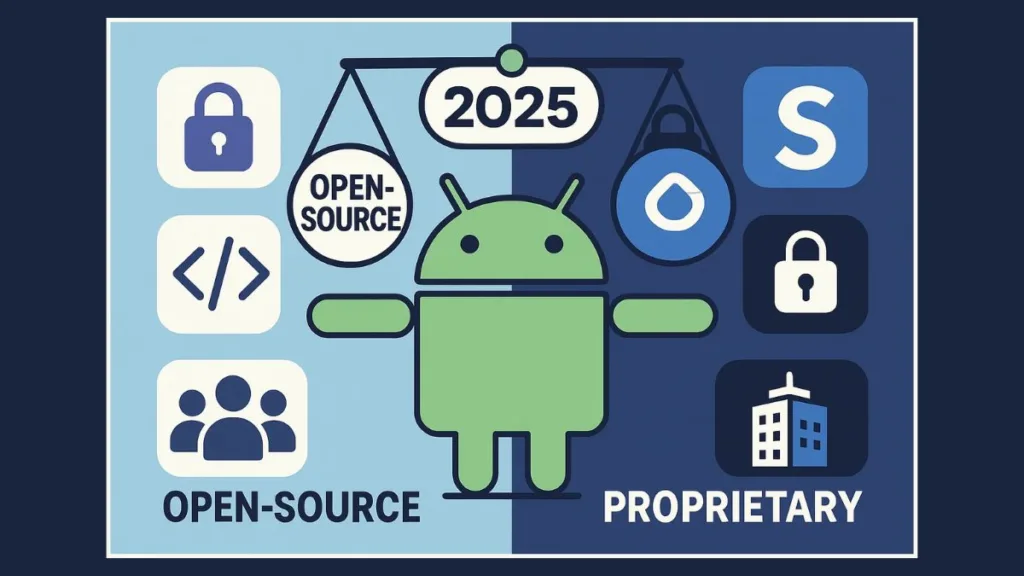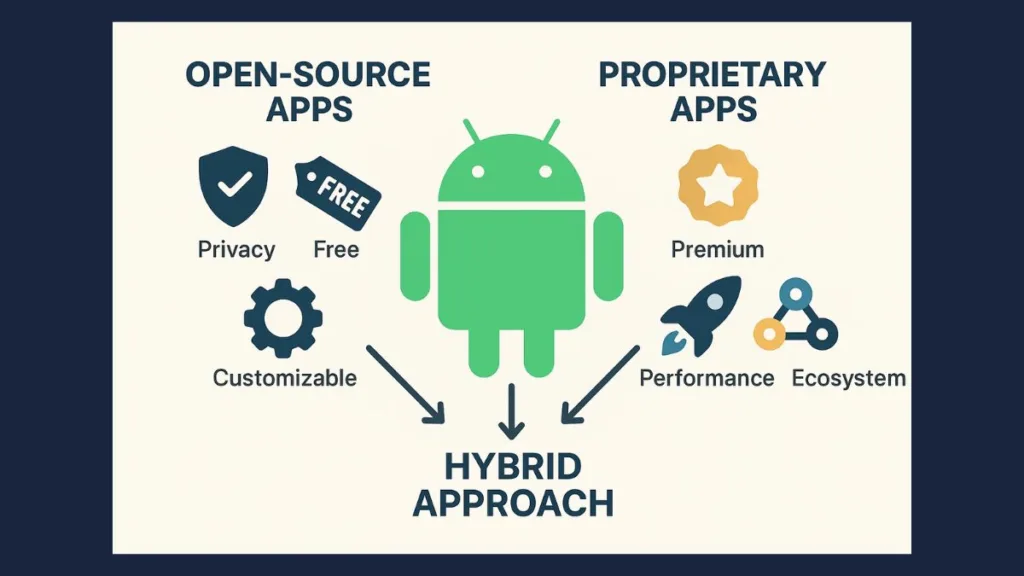Wondering which is better in 2025: Open-Source vs Proprietary Android Apps (Open Source vs Closed Source)? Explore key differences, pros & cons, and what to choose.
Choosing between open-source vs proprietary Android apps has never been more important than in 2025. With over 8.93 million mobile apps available globally and the Google Play Store hosting 3.553 million apps, the Android ecosystem is massive. Yet, hidden beneath the numbers is a key question: should you put your trust in open-source apps built by communities, or proprietary apps controlled by companies?

In this guide, we’ll break down the differences, highlight the advantages and disadvantages, and help you make an informed choice on whether open-source Android apps or closed-source apps better fit your needs.
What “Open-Source” vs “Proprietary” Means for Android
Open-source Android apps make their source code publicly available under an open license. This means anyone can inspect, modify, and redistribute the code. Distribution often happens via repositories like F-Droid, a volunteer-driven store that builds apps directly from source.
- F-Droid’s unique model: OSS-only repository, reproducible builds, no proprietary components, and support for privacy-friendly delivery methods (Tor, local sharing, privileged extensions for background updates).
Proprietary Android apps, on the other hand, keep their source code closed. Users only receive compiled binaries through centralized stores like Google Play, where vendors control licensing, updates, telemetry, and feature roadmaps.
- Google Play dominance: Large-scale studies show a small fraction of free apps drive most downloads, and popular apps often rely on advertising SDKs and native libraries for performance and monetization.
Quick example: F-Droid prioritizes transparency and privacy, while Google Play emphasizes scale, monetization, and integrations.
Market Snapshot: The Android App Ecosystem in 2025
- There are an estimated 8.93 million mobile apps worldwide.
- Google Play Store alone lists 3.553 million apps in 2025.
- F-Droid, the primary open-source app repository, has a much smaller but active catalog.
- In 2024 alone, it saw 7,205 app updates, 402 new apps, and 939 apps archived, showing active curation and sustainability.
Context: Proprietary apps dominate global app revenue—over $613B+ across platforms—but open-source continues to show resilience. F-Droid’s volunteer-led curation demonstrates a sustainable governance model, even at smaller scale.
Security and Privacy: Auditability vs Vendor Assurance
- Open-source apps: Anyone can audit the source code, which makes vulnerabilities easier to detect and fix. Features like reproducible builds and transparent CI/CD pipelines (like F-Droid’s policies) reduce supply-chain risks.
- Community advantage: Because multiple contributors can inspect code, flaws are surfaced quickly. This collaborative approach boosts security and reliability—provided governance is strong.
- Proprietary apps: Security depends on the vendor’s disclosure and patch cadence. Because the code is closed, independent verification is limited—you must trust the company’s claims.
Key takeaway: If privacy and transparency are your top priorities, open-source software advantages shine here. Proprietary apps may still deliver fast patches, but visibility is limited.
Cost, Support, and Vendor Lock-In
- Open-source apps are usually free, with peer or community support. They offer high customization and flexibility without vendor lock-in. But continuity depends on volunteers, so sustainability varies.
- Customization edge: Organizations can fork and adapt apps to their specific needs without worrying about licensing barriers.
- Proprietary apps offer dedicated customer support, SLAs, and polished onboarding. But you’re locked into their licensing, data policies, and upgrade cycles—often with recurring subscription costs.
Example: Want complete control over your privacy? Check our Best Open Source Privacy Apps for Android 2025.
Performance and Ecosystem Integrations
- Proprietary apps usually have the edge here. They’re optimized with native libraries, SDKs, and performance-tuned frameworks—a reason why top apps on Play rely heavily on closed components and advertising SDKs.
- They also benefit from tight ecosystem integration with services like Google Play Services, DRM, and proprietary APIs, which are critical for apps like streaming platforms and enterprise tools.
- Open-source apps may lack seamless integration with proprietary services, requiring extra steps for compatibility.
That said, some best open-source Android apps in 2025 rival their proprietary counterparts in speed and polish, especially for utilities and music players (Best Open Source Music Player for Android).
Popularity and Community Dynamics
Open-source popularity is often tied to social and technical factors: GitHub stars, forks, Play Store ratings, and download counts. Research shows these signals help drive adoption even in a smaller ecosystem.
Proprietary apps, by contrast, dominate downloads thanks to marketing budgets, commercial incentives, and ecosystem lock-in.
Still, open-source projects gain traction when communities rally around them—examples include open-source browsers, password managers, and email clients.
When to Choose Open-Source vs Proprietary Android Apps

Here’s a practical decision matrix for 2025:
Consider open-source apps when:
- You prioritize privacy, transparency, and auditability (e.g., secure messaging, tracker-free utilities).
- You want to avoid vendor lock-in and ensure long-term portability across devices and regions.
- Budget constraints favor license-free deployment and you have the technical capability to manage apps.
Consider proprietary apps when:
- You need turnkey UX, dedicated support, and commercial integrations.
- You rely on ecosystem-specific features like Play Services, DRM, or performance-tuned native libraries.
- Time-to-value and predictable maintenance matter more than deep customization.
For a curated list of tools to try, check out our guide to Best Open Source Apps for Android 2025.
Frequently Asked Questions about Open-Source vs Proprietary Android Apps (2025)
What is the difference between open-source and proprietary Android apps?
Open-source apps make their source code public, meaning anyone can inspect, modify, and redistribute them. Proprietary apps keep their code closed, controlled by the developer or company, and often come with licensing restrictions.
Are open-source Android apps more secure than proprietary apps?
Yes, open-source Android apps are often considered more secure because the code is transparent and can be audited by the community. However, security also depends on how actively the app is maintained and updated. Proprietary apps rely on vendor patches, which may be delayed.
Why should I use open-source apps on Android in 2025?
Open-source apps are privacy-friendly, free, and customizable. In 2025, they’ve grown significantly with strong support from platforms like F-Droid, offering thousands of audited apps without hidden trackers.
Are proprietary Android apps better for performance?
Proprietary apps usually have more polished features, seamless integration with ecosystems like Google or Microsoft, and professional design teams behind them. This often gives them a performance and usability edge over open-source apps.
Can I replace all proprietary apps with open-source alternatives?
Not entirely. While many proprietary apps have open-source replacements (e.g., messaging, privacy tools, music players), some areas like gaming, enterprise tools, and advanced AI apps are still dominated by proprietary solutions. A hybrid approach works best.
Which is better for privacy: open-source or proprietary apps?
Open-source apps generally win when it comes to privacy since they avoid unnecessary trackers, and the code can be reviewed by anyone. Proprietary apps may collect data for advertising or analytics, though premium versions sometimes reduce tracking.
How do I install open-source apps on Android?
You can download open-source Android apps from trusted repositories like F-Droid or directly from GitHub. For broader access, you can still use the Google Play Store, which also hosts some open-source apps.
Will open-source Android apps replace proprietary apps in the future?
Not completely. Open-source apps are expanding rapidly in 2025, especially in categories like privacy, productivity, and entertainment. But proprietary apps will continue to dominate areas with heavy R&D investment, exclusive licenses, or advanced integrations.
Quick Comparison: Open-Source vs Proprietary Android Apps (2025)
| Factor | Open-Source Android Apps | Proprietary Android Apps |
|---|---|---|
| Source Code | Publicly available, auditable, and forkable | Closed, vendor-controlled |
| Distribution | Community repositories (e.g., F-Droid: OSS-only, reproducible builds, Tor/local sharing, privileged extension for updates) | Centralized stores (e.g., Google Play: monetization, analytics, DRM, policy enforcement) |
| Scale (2025) | Thousands of apps (F-Droid: 7,205 updates, 402 new apps, 939 archived in 2024) | 3.553M apps on Google Play; global total 8.93M apps |
| Security & Privacy | Transparent code audits, community reviews, quicker discovery of vulnerabilities | Relies on vendor patch cadence, limited external auditability |
| Customization & Lock-In | Highly customizable, no vendor lock-in, forkable | Locked into vendor licenses, SDKs, and ecosystem dependencies |
| Cost | Typically free, no licensing fees; integration/maintenance may require expertise | Licensing/subscription costs, but with bundled features and SLAs |
| Support | Community-driven forums, wikis, and peer support | Dedicated customer support, onboarding, SLAs |
| Performance & Integrations | May lack seamless integration with proprietary services; strong for utilities and niche tools | Optimized with native libraries, DRM, SDKs; polished UX and ecosystem integrations |
| Popularity & Growth | Driven by GitHub stars, forks, ratings, and niche communities | Dominant in downloads and revenue ($613B+ app revenue across platforms in 2025) |
Conclusion: Striking the Balance in 2025
So, open-source vs proprietary software—which is better? The answer depends on what you value most.
- If you want freedom, transparency, and control, open-source is the clear winner.
- If you want polish, integrations, and dedicated support, proprietary makes sense.
The best approach? A hybrid model—use open-source apps where privacy matters most (browsers, password managers, utilities) and proprietary apps where convenience and integrations matter (productivity suites, AI-powered tools).
Your Android experience in 2025 can be as open—or as closed—as you choose. The key is knowing when to trade control for convenience.
Visit Our Post Page: Blog Page
